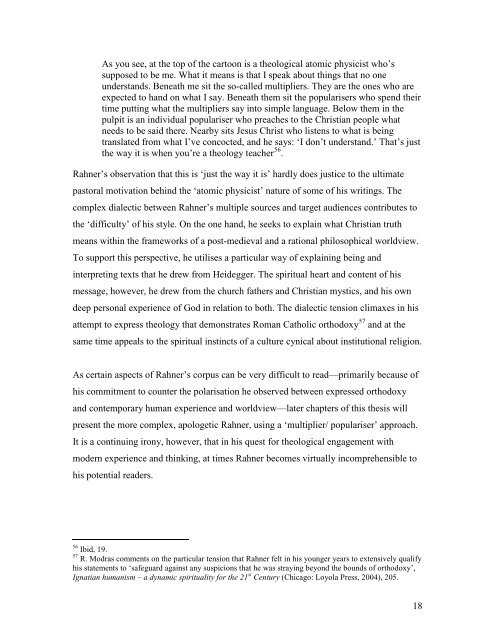Introductory notes for readers of this thesis - Theses - Flinders ...
Introductory notes for readers of this thesis - Theses - Flinders ...
Introductory notes for readers of this thesis - Theses - Flinders ...
You also want an ePaper? Increase the reach of your titles
YUMPU automatically turns print PDFs into web optimized ePapers that Google loves.
As you see, at the top <strong>of</strong> the cartoon is a theological atomic physicist who’ssupposed to be me. What it means is that I speak about things that no oneunderstands. Beneath me sit the so-called multipliers. They are the ones who areexpected to hand on what I say. Beneath them sit the popularisers who spend theirtime putting what the multipliers say into simple language. Below them in thepulpit is an individual populariser who preaches to the Christian people whatneeds to be said there. Nearby sits Jesus Christ who listens to what is beingtranslated from what I’ve concocted, and he says: ‘I don’t understand.’ That’s justthe way it is when you’re a theology teacher 56 .Rahner’s observation that <strong>this</strong> is ‘just the way it is’ hardly does justice to the ultimatepastoral motivation behind the ‘atomic physicist’ nature <strong>of</strong> some <strong>of</strong> his writings. Thecomplex dialectic between Rahner’s multiple sources and target audiences contributes tothe ‘difficulty’ <strong>of</strong> his style. On the one hand, he seeks to explain what Christian truthmeans within the frameworks <strong>of</strong> a post-medieval and a rational philosophical worldview.To support <strong>this</strong> perspective, he utilises a particular way <strong>of</strong> explaining being andinterpreting texts that he drew from Heidegger. The spiritual heart and content <strong>of</strong> hismessage, however, he drew from the church fathers and Christian mystics, and his owndeep personal experience <strong>of</strong> God in relation to both. The dialectic tension climaxes in hisattempt to express theology that demonstrates Roman Catholic orthodoxy57 and at thesame time appeals to the spiritual instincts <strong>of</strong> a culture cynical about institutional religion.As certain aspects <strong>of</strong> Rahner’s corpus can be very difficult to read—primarily because <strong>of</strong>his commitment to counter the polarisation he observed between expressed orthodoxyand contemporary human experience and worldview—later chapters <strong>of</strong> <strong>this</strong> <strong>thesis</strong> willpresent the more complex, apologetic Rahner, using a ‘multiplier/ populariser’ approach.It is a continuing irony, however, that in his quest <strong>for</strong> theological engagement withmodern experience and thinking, at times Rahner becomes virtually incomprehensible tohis potential <strong>readers</strong>.56 Ibid, 19.57 R. Modras comments on the particular tension that Rahner felt in his younger years to extensively qualifyhis statements to ‘safeguard against any suspicions that he was straying beyond the bounds <strong>of</strong> orthodoxy’,Ignatian humanism – a dynamic spirituality <strong>for</strong> the 21 st Century (Chicago: Loyola Press, 2004), 205.18















